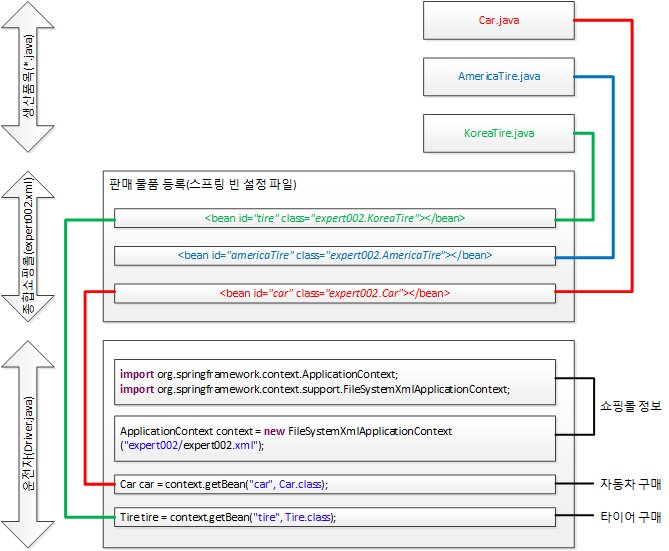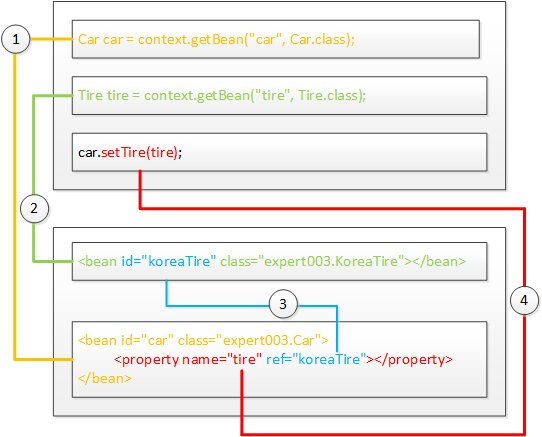2022.03.23
스프링 삼각형과 설정 정보
스프링 없이 의존성 주입하기1 - 생성자를 통한 의존성 주입
- 운전자가 타이어를 생산한다 => Tire tire = new KoreaTire();
- 운전자가 자동차를 생산하면서 타이어를 장착한다. => Car car = new Car(tire);
- 의존성 주입 == 외부에서 new해서 주입해주는것
package com.heaven.mvc.expert001_02;
public class Car {
Tire tire;
public Car(Tire tire) {
this.tire = tire;
}
public String getTireBrand() {
return "장착된 타이어: "+tire.getBrand();
}
}
package com.heaven.mvc.expert001_02;
public class Driver {
public static void main(String[] args) {
Tire tire = new KoreaTire();
Car car = new Car(tire);
System.out.println(car.getTireBrand());
}
}
- 의존성 주입을 적용할 경우 해당 인터페이스를 구현한 어떤 객체가 들어오기만 하면 정상적으로 작동
- 확장성 좋아짐
스프링 없이 의존성 주입하기2 - 속성을 통한 의존성 주입
- 운전자가 타이어를 생산한다
=> Tire tire = new Tire();
- 운전자가 자동차를 생산하다
=> Car car = new Car();
- 운전자가 자동차에 타이어를 장착한다.
=> car.setTire(tire);
package com.heaven.mvc.expert001_03;
public class Car {
Tire tire;
public String getTireBrand() {
return "장착된 타이어: "+tire.getBrand();
}
public Tire getTire() {
return tire;
}
public void setTire(Tire tire) {
this.tire = tire;
}
}
package com.heaven.mvc.expert001_03;
public class Driver {
public static void main(String[] args) {
Tire tire = new KoreaTire();
Car car = new Car();
car.setTire(tire);
System.out.println(car.getTireBrand());
}
}
스프링을 통한 의존성 주입 - XML 파일 사용
- 운전자가 종합 쇼핑몰에서 타이어를 구매한다
운전자가 종합 쇼핑몰에서 자동차를 구매한다.
운전자가 자동차에 타이어를 장착한다
ApplicationContext context = new ClassPathXmlApplicationContext("com/heaven/mvc/expert002/expert002.xml");
Tire tire = context.getBean("tire", Tire.class);
Car car = context.getBean("car",Car.class);
car.setTire(tire);
- 스프링을 통한 의존성 주입은 생성자를 통한 의존성 주입과 속성을 통한 의존성 주입을 모두 지원
package com.heaven.mvc.expert002;
import org.springframework.context.ApplicationContext;
import org.springframework.context.support.ClassPathXmlApplicationContext;
public class Driver {
public static void main(String[] args) {
ApplicationContext context = new ClassPathXmlApplicationContext("com/heaven/mvc/expert002/expert002.xml");
Tire tire = context.getBean("tire", Tire.class);
Car car = context.getBean("car",Car.class);
car.setTire(tire);
System.out.println(car.getTireBrand());
}
}
<?xml version="1.0" encoding="UTF-8"?>
<beans xmlns="http://www.springframework.org/schema/beans"
xmlns:xsi="http://www.w3.org/2001/XMLSchema-instance"
xsi:schemaLocation="http://www.springframework.org/schema/beans http://www.springframework.org/schema/beans/spring-beans.xsd">
<bean id="tire" class="com.heaven.mvc.expert002.KoreaTire"></bean>
<bean id="americaTire" class="com.heaven.mvc.expert002.AmericaTire"></bean>
<bean id="car" class="com.heaven.mvc.expert002.Car"></bean>
</beans>

스프링을 통한 의존성 주입 - 스프링 설정 파일(XML)에서 속성 주입
- 의사코드(점점 더 현실 세계와 비슷해짐)
- 운전자가 종합 쇼핑몰에서 자동차 구매를 요청한다.
- 종합 쇼핑몰에서 타이어를 생산한다.
- 종합 쇼핑몰에서 자동차를 생산한다.
- 종합 쇼핑몰에서 자동차에 타이어를 장착한다
- 종합 쇼핑몰은 운전자에게 자동차를 전달한다.
ApplicationContext context = new ClassPathXmlApplicationContext("com/heaven/mvc/expert003/expert003.xml");
Car car = context.getBean("car",Car.class);
<bean id="koreaTire" class="com.heaven.mvc.expert003.KoreaTire"></bean>
<bean id="americaTire" class="com.heaven.mvc.expert003.AmericaTire"></bean>
<bean id="car" class="com.heaven.mvc.expert003.Car">
<property name="tire" ref="americaTire"></property>
</bean>

스프링을 통한 의존성 주입 - @Autowired를 통한 주입
- import문 하나와 @Autowired 어노테이션을 이용하면 설정자 메서드를 이용하지 않고도 스프링 프레임워크가 설정 파일을 통해 설정자 메서드 대신 속성을 주입해준다.
- @Autowired
- 스프링 설정 파일 보고 자동으로 속성의 설정자 메서드(set)에 해당하는 역활을 해주겠다.
- bean config file에서 namespace - context를 추가
<?xml version="1.0" encoding="UTF-8"?>
<beans xmlns="http://www.springframework.org/schema/beans"
xmlns:xsi="http://www.w3.org/2001/XMLSchema-instance"
xmlns:context="http://www.springframework.org/schema/context"
xsi:schemaLocation="http://www.springframework.org/schema/beans http://www.springframework.org/schema/beans/spring-beans.xsd
http://www.springframework.org/schema/context http://www.springframework.org/schema/context/spring-context-3.1.xsd">
<context:annotation-config/>
<bean id="tire" class="com.heaven.mvc.expert004.KoreaTire"></bean>
<bean id="americaTire" class="com.heaven.mvc.expert004.AmericaTire"></bean>
<bean id="car" class="com.heaven.mvc.expert004.Car"></bean>
</beans>
package com.heaven.mvc.expert004;
import org.springframework.beans.factory.annotation.Autowired;
public class Car {
@Autowired
Tire tire;
public String getTireBrand() {
return "장착된 타이어: "+tire.getBrand();
}
}
package com.heaven.mvc.expert004;
import org.springframework.context.ApplicationContext;
import org.springframework.context.support.ClassPathXmlApplicationContext;
public class Driver {
public static void main(String[] args) {
ApplicationContext context = new ClassPathXmlApplicationContext("com/heaven/mvc/expert004/expert004.xml");
Car car = context.getBean("car",Car.class);
System.out.println(car.getTireBrand());
}
}



